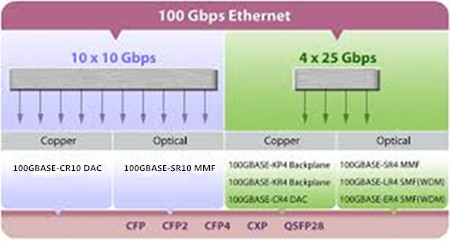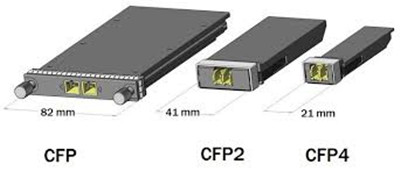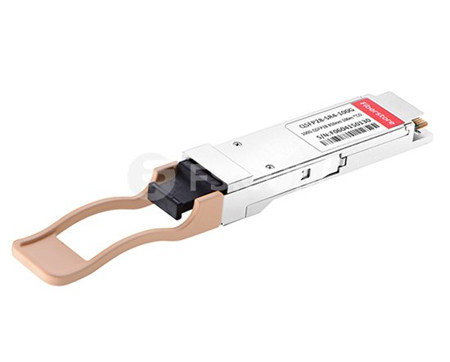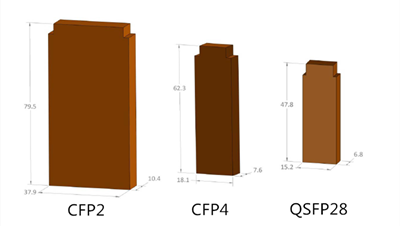Ethernet as the networking standards, enables computers to locally connect to each other, which is the ultra-strong backbone to the many networks we use every day. Although most of the Ethernet market is still running around 1 Gbqs or 10 Gbqs, there is a strong interest in higher data rates. Many hardware vendors like Cisco, Finisar, Huawei and Brocade have recently announced support for 100 Gigabit Ethernet and telecom vendors around the world have also shown interest in launching 100G networks. All these events shows the sign of the advent of 100 Gigabit Ethernet in the commercial segment. However, is it necessary to move to 100G now? Or should the 100g migration be a smooth one just as the IEEE has made when moving to 40G? This article will highlight the reasons and solutions of upgrading to 100G.

Why Move to 100G?
- Most enterprises today are encouraging telecommuting and promote real-time, high-definition, high-quality voice and video solutions. All these require a huge bandwidth capacity. Additionally, 100G implementations offer an effective means to operate seamlessly within an existing 10G network infrastructure, avoid the need for additional optical amplifiers, dispersion compensators or regenerators. 100G is today’s choice to scale networks in a way that delivers the required capacity in the most efficient manner, readying the network for tomorrow’s bandwidth crunch.
- Another interesting point is the efficiency of 100G Ethernet compared to link aggregation that is used today. As of now, a 10 x 10G Ethernet link aggregation can not give a throughput of up to 100 Gbps. This limitation can be overcome with a true 100G connection which can give a 100Gbps bandwidth, thus allowing high capacity links to scale even further. Considering all these, if not this year or the next, 100G will be widely adopted soon.
- Last but not the least, the industry have come together in order to create a healthy 100G ecosystem, which will be beneficial for the entire community. This broad inclusion will result in a fast introduction of 100G solutions that will meet industry performance, size, cost, and power requirements. If the cost drive is right, once 100G is standardized and commercially available, network operators will quickly capitalize 40G investments and adopt 100G transmission for their future deployments.
Migrate to 100G with 100G Transceiver Modules
There are several form factors for supporting 100GbE including CFP, CFP2, CFP4, QSFP28 and CPAK. The following will make a clear introduction to all of them.
CFP Transceiver
The CFP is the very first 100G transceiver for the transmission of high-speed digital signals, the C stands for the Latin letter centum (means 100). The CFP module was designed after the SFP interface, but is significantly larger to support 100 Gbqs using 10 x 10 Gbit/s lanes in each direction (RX, TX). The optical connection can support both 10 x 10 Gbit/s and 4 x 25 Gbit/s variants of 100 Gbit/s interconnects. There are four common types of CFP transceiver modules, such as 100GBASE-SR10 in 100 meter MMF, 100GBASE-LR10 and 100GBASE-LR4 in 10 km SMF reach, and 100GBASE-ER10 and 100GBASE-ER4 in 40 km SMF reach respectively.

As improvements in technology have allowed higher performance and higher density, which drives the development of the CFP2 and CFP4 specifications. While CFP, CFP2 and CFP4 are electrical similar, they specify a form-factor of 1/2 and 1/4 respectively in size of the original specification. Note that CFP, CFP2 and CFP4 modules are not interchangeable, but would be inter-operable at the optical interface with appropriate connectors.
QSFP28 Transceiver
QSFP28 is the same footprint as the 40G QSFP+ module. Just as the 40G QSFP+ module is using four 10Gbps lanes, the 100G QSFP28 is implemented with four 25Gbps lanes. In all QSFP versions, both the electrical lanes and the optical lanes operate at the same speed, eliminating the costly gearbox found in CFP, CFP2, and the CPAK. The QSFP28 module has an upgraded electrical interface to support signaling up to 28Gbps signals, yet keeps all of the physical dimensions of its predecessor. As QSFP28 technology becomes even maturer, QSFP28 transceivers will become more and more popular in 100G optics market. The above image shows a QSFP-100G-SR4-S. it is Cisco 100GBASE-SR4 QSFP28 transceiver module.

100GBASE-SR4 QSFP28 transceiver and 100GBASE-LR4 QSFP28 transceiver are the two main types of the QSFP28 transceivers. The former is specified to operate over multimode fiber (MMF) with the maximum link length of 70m on OM3 and 100m on OM4, while 100GBASE-LR4 QSFP28 is standardized to work through single-mode fiber (SMF), able to realize 10km link length.
QSFP28 vs. CFP
QSFP28 and CFP are the two common 100G optical transceivers available on the market. As noted before, CFP is the first-generation 100G transceiver. It is the common scene that QSFP28 makes an appearance and CFP takes a bow, which reflects the trend in the industry to aggressively bring 100GE density up and costs down. CFP4 is half the width of CFP2, which is half again the width of CFP. QSFP28 has the same footprint and faceplate density as QSFP+ and is just slightly smaller than CFP4. Theoretically, QSFP28 seems to have the density advantage over CFP4, but CFP4’s higher maximum power consumption gives it the advantage on longer reach optical distances. However, the CFP is much more expensive than QSFP28 and will not be used for lower speeds because of the high cost.

CPAK Transceiver
CPAK is another newcomer to supporting 100G network. This is a proprietary form factor from Cisco but the interfaces demonstrated are IEEE standards and will interoperate with the same interfaces supported by other form-factors. Together, these solutions will deliver the smallest form-factor, most efficient 100-Gbps optical transceiver portfolio in the industry. Cisco CPAK will be available in several IEEE-standard optical interfaces.
Conclusion
Within the next several years, 100G is doom to become the dominant backbone technology in terms of its high capacity over 10G and surpassing would-be high-speed contender 40G. Of course, we must count on the components and systems suppliers to build products that meet technical and economic requirements while allowing a smooth migration to the 100G infrastructure that is being put in operation today. Fiberstore as a rising telecom supplier, is committed to promote telecommunication development. We recently release a full range of 100G optical transceivers including CFP, CFP2, CFP4, QSFP28 and QSFP28 DAC cables. All of our products are fully compatible with the original brand. If you have any requirement, you can send your request to us.

Thank you for the information structured cabling service
ReplyDelete